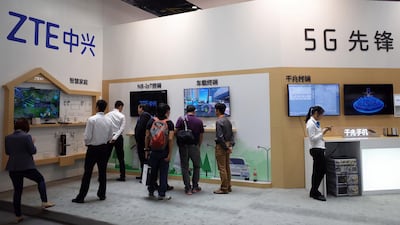ZTE may have just gone from being a serious contender in the high-stakes world of next-generation networking to - quite possibly - a mobile industry washout.
China’s second-largest telecommunications gear-maker was preparing to lead the country’s charge into the era of blazing fast fifth-generation wireless technology, along with local rival Huawei Technologies. Instead, ZTE ran afoul of Washington for the second time in a year, inciting a moratorium on purchases from US suppliers and suffering a devastating blow to its global ambitions.
It couldn’t have happened at a worse time. ZTE finds itself grappling with life-threatening sanctions once more just as major wireless carriers prepare to roll out 5G networks worldwide. The US government slapped a seven-year ban on its purchase of components from American companies for ignoring promises made in 2017 to resolve a sanctions dispute - then lying about it.
The moratorium threatens a swathe of components needed to hawk gear to clients like China Mobile and Europe’s Telefonica. The Chinese firm relies on suppliers from Qualcomm and Micron Technology to Lumentum and Acacia Communications for optical components and chipsets in the equipment and smartphones it sells globally.
“Even if this doesn’t kill them, ZTE will be half-dead,” said Qian Kai, an analyst with brokerage CICC.
ZTE’s best hope may be for swift intervention to resolve the dispute from Beijing - but that is a long shot given rising tensions between the US and China. President Donald Trump has threatened tariffs on $150 billion of Chinese imports in retaliation for alleged violations of intellectual property rights, while Beijing has vowed to retaliate on everything from American soya beans to planes.
Following the ZTE ban, China’s Ministry of Commerce on Tuesday said it would take necessary measures to protect the interests of its companies. And ZTE said it was aware of the sanctions and evaluating their impact. Its shares were suspended from trade in Hong Kong and Shenzhen.
US-made components account for only 10 to 15 per cent of ZTE’s production costs, estimates Nomura analyst Joel Ying. “But these are essential parts that aren’t easily replaced,” he said. ZTE’s smartphones, for instance, rely on Qualcomm’s chips. “At least for the next five to 10 years, ZTE can’t exist without American companies.”
Things seemed to be going well for ZTE. A year ago, it appeared to mollify a US Commerce Department incensed over illegal exports to Iran by agreeing to pay a fine of up to $1.2bn and punish wayward staff. ZTE’s market value doubled over the past year, and consumer division chief Cheng Lixin spoke openly about breaking into Apple’s home turf. And 5G spending looked like a tremendous boon: Chinese carriers alone are expected to spend $538bn on networks from 2018 to 2025, Jefferies estimates.
________________
Read more:
China tech discrimination by US is hurting all sides
Trump security team sees building US 5G network as option
________________
Then the US issued its ban, charging that instead of punishing employees for violating sanctions ZTE had paid them full bonuses. US optical suppliers such as Acacia and Lumentum dived, while greater China partners also plummeted.
Analysts delivered a flurry of downgrades on concern ZTE will miss out on future business. The 5G networks are supposed to usher in artificial intelligence, virtual reality and other bleeding-edge applications.
The ban “will likely cause ZTE to lose market share in both transmission and handsets”, Edison Lee, an analyst with Jefferies, wrote Tuesday. “Expect another settlement with the US to take 3 to 5 months. But customer confidence outside China will take longer to restore, especially potential 5G customers.”
The ban comes days after President Xi Jinping called on the US to allow Chinese companies to buy more high-tech products from American companies - whittling away at a ballooning trade surplus. Now, a potential victim could be Qualcomm: Chinese anti-trust regulators are reviewing its proposed NXP Semiconductors acquisition, CICC reminded investors.
ZTE could try sussing out alternatives in Japan, Korea or Taiwan for certain non-essential components. But it depends on the US for top-notch processors such as high-speed analog-to-digital converters and communications chips, according to Roger Sheng, an analyst with Gartner.
CICC analysts Huang Leping and Wang Xinglin estimate ZTE harbours about one to two months of inventory, after which the US sanctions will begin to bite. But for now, ZTE’s woes represent a boon for larger rival Huawei, which remains unfettered by similar restrictions.
Together, they rank among the world’s largest providers of networking equipment and are active across Europe and Asia - less so in the US, where the government remains suspicious of their alleged government connections. Both have dismissed such accusations. CICC estimates ZTE commands about a 10 per cent share of the global telecoms equipment market, and 30 per cent of China. Huawei could now take advantage of the uncertainty surrounding its competitor.
But the troubles for both companies may not be over. The US Federal Communications Commission on Tuesday plans to consider a ban on networking equipment from companies including ZTE and Huawei.

